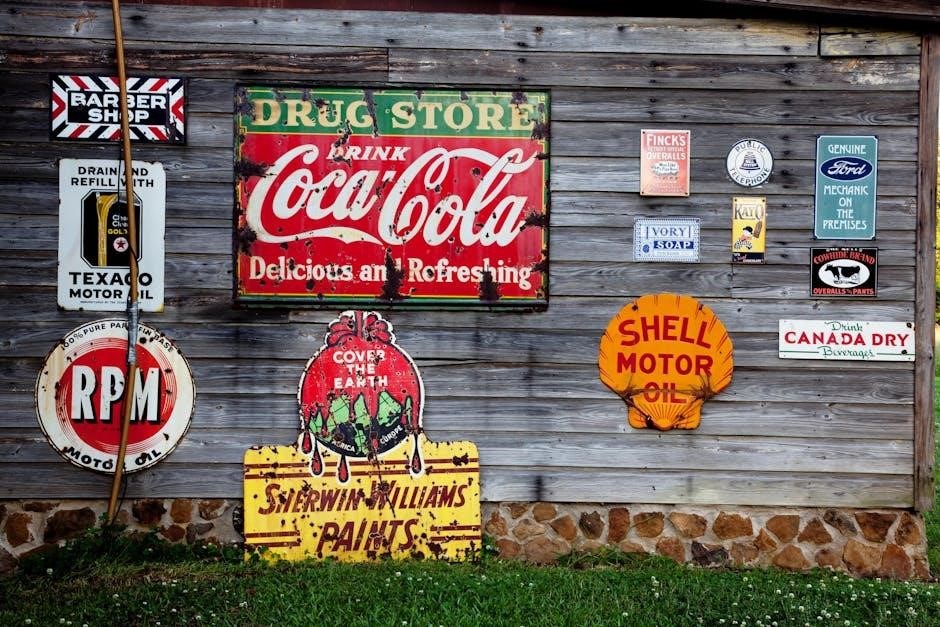The 2024 Ford Towing Guide is your ultimate resource for detailed towing capacities, safety tips, and advanced technologies․ It helps Ford vehicle owners make informed decisions for secure and confident hauling experiences․

2024 Ford Vehicle Lineup for Towing
Ford’s 2024 lineup offers a diverse range of vehicles tailored for towing, from the F-150 to the F-350, Mustang Mach-E, Explorer, Bronco, and Ranger, each designed to meet specific towing needs with precision and power․
Ford F-150 Towing Capacity and Features
The Ford F-150 is renowned for its impressive towing capabilities, with a maximum capacity of up to 14,000 pounds, depending on the engine and axle ratio․ Its high-strength steel frame and military-grade aluminum alloy body ensure durability and strength for heavy loads․ The F-150 offers a range of engine options, including the 2․7L V6 EcoBoost, which balances power and efficiency․ Advanced features like Trailer Sway Control and Blind Spot Monitoring enhance safety and convenience while towing․ The Pro Trailer Backup Assist is another standout feature, simplifying the process of maneuvering trailers․ With its robust construction, powerful engines, and cutting-edge technologies, the F-150 is a versatile choice for both recreational and work-related towing needs․ Whether hauling boats, trailers, or equipment, the F-150 delivers reliability and performance, making it a top pick for those seeking a capable and feature-rich towing vehicle․
Ford F-250 and F-350 Heavy-Duty Towing
The Ford F-250 and F-350 are engineered for heavy-duty towing, offering exceptional capabilities for demanding tasks․ The F-250 can tow up to 20,000 pounds, while the F-350 reaches an impressive 35,000 pounds, making them ideal for large trailers and heavy equipment․ Both models feature a robust frame and axle design, along with powerful engine options like the 6․7L Power Stroke V8 diesel, delivering unmatched torque and strength․ Advanced towing technologies, such as a trailer brake controller and rearview camera, enhance control and safety․ The F-250 and F-350 are designed for commercial and industrial use, providing reliability and durability for the toughest jobs․ Whether hauling construction equipment or large RVs, these trucks are built to handle heavy loads with confidence․ Their combination of power, advanced features, and rugged construction makes them the ultimate choice for heavy-duty towing needs, ensuring a safe and efficient experience for professionals and enthusiasts alike․
Ford SUVs for Towing — Mustang Mach-E and Explorer
Ford SUVs like the Mustang Mach-E and Explorer are designed to deliver impressive towing capabilities while offering advanced technology and safety features․ The Mustang Mach-E, with its electric powertrain, can tow up to a certain capacity, making it ideal for smaller trailers or boats․ The Explorer, equipped with a powerful engine, offers a higher towing capacity, suitable for larger trailers and heavier loads․ Both vehicles feature advanced towing technologies, including trailer sway control and blind spot monitoring, to ensure secure and confident towing experiences․ The Mustang Mach-E and Explorer are perfect for those who need a reliable and powerful SUV for towing, whether for recreational or practical purposes․ By consulting the guide de remorquage Ford 2024, owners can determine the exact towing capacities and make informed decisions about their hauling needs, ensuring a safe and successful towing experience․
Ford Ranger and Transit Towing Capabilities

The Ford Ranger and Transit are versatile vehicles designed to meet various towing needs․ The Ranger, known for its durability and performance, offers a maximum towing capacity of up to 7,500 pounds, making it ideal for hauling trailers, boats, or equipment․ Its robust chassis and powerful engine options, such as the 2․3L EcoBoost, ensure reliable towing performance․ The Transit, a popular choice for commercial and recreational use, provides a towing capacity of up to 4,400 pounds, suitable for smaller trailers or work equipment․ Both vehicles feature advanced towing technologies, including Trailer Sway Control and Blind Spot Monitoring, to enhance safety and confidence while towing․ The guide de remorquage Ford 2024 provides detailed specifications for each model, helping owners determine the best configuration for their towing needs․ Whether for work or play, the Ranger and Transit deliver a balance of power, capability, and safety, making them excellent choices for a wide range of towing applications․

Factors Affecting Towing Capacity
The towing capacity of a Ford vehicle is influenced by its engine, transmission, and axle ratio, as well as the trailer type and configuration․ These factors determine the maximum weight a vehicle can safely tow․
Engine, Transmission, and Axle Ratio

The engine, transmission, and axle ratio are critical factors in determining a Ford vehicle’s towing capacity․ A more powerful engine, such as the 2․7L V6 EcoBoost in the F-150 or the 6․7L Power Stroke V8 diesel in the F-250 and F-350, delivers higher torque and horsepower, enabling heavier towing․ The transmission plays a key role in transferring power efficiently, with models like the 10-speed automatic optimizing performance under load․ The axle ratio also impacts towing capability, as a lower ratio provides better fuel efficiency for lighter loads, while a higher ratio, such as 3․55 or 3․73, enhances low-end torque for heavy towing․ Properly matching these components ensures maximum towing performance and stability․ Ford’s advanced engineering balances these elements to provide a robust towing experience across its lineup, from lightweight trailers to heavy-duty hauls․ Always consult the guide for specific configurations to maximize safety and efficiency․
Trailer Type and Configuration
The type and configuration of your trailer significantly impact towing performance․ According to the 2024 Ford Towing Guide, understanding trailer specifications is essential for safe and efficient hauling․ Travel trailers, boat trailers, and utility trailers each have unique requirements, with varying weights and aerodynamic profiles․ Proper trailer configuration, including tongue weight and load distribution, ensures stability and control․ Ford vehicles are equipped with advanced technologies like trailer sway control to mitigate potential issues․ The guide emphasizes the importance of matching the trailer type to the vehicle’s towing capacity, as specified in the owner’s manual․ Incorrect configurations can lead to reduced performance or safety hazards․ Always consult the guide for specific recommendations tailored to your Ford model and trailer setup․ This ensures a secure and confident towing experience, whether for recreational or commercial purposes․ Proper trailer configuration is a cornerstone of safe and effective towing with Ford vehicles․
Proper Towing Equipment
Proper towing equipment is essential for safe and efficient hauling․ Use a compatible hitch, ball mount, and wiring harness․ Ensure trailer brakes are correctly installed and functioning․ Always follow Ford’s guidelines for secure towing experiences․
Hitch and Ball Mount Selection
Selecting the right hitch and ball mount is crucial for safe and effective towing․ The hitch must match your vehicle’s towing capacity and the trailer’s weight․ Choose a hitch class rated for your trailer’s gross trailer weight (GTW)․ The ball mount should fit the hitch receiver and be sized to accommodate the trailer’s coupler․ Ensure the ball diameter matches the trailer’s hitch for proper coupling․ Ford recommends using OEM or compatible aftermarket components for reliability․ Always follow the manufacturer’s guidelines for installation and torque specifications․ Regularly inspect the hitch and ball mount for wear or damage․ Proper alignment and secure attachment are essential to prevent sway and maintain control while towing․ Refer to the 2024 Ford Towing Guide for specific recommendations tailored to your vehicle and trailer setup․ This ensures a safe and confident towing experience, whether for work or recreation․
Wiring Harness and Trailer Brakes
A properly installed wiring harness is essential for safe and reliable towing․ It ensures that your trailer’s lights, brakes, and electrical systems function correctly․ Ford recommends using a vehicle-specific wiring harness to guarantee compatibility and ease of installation․ For trailers equipped with brakes, a trailer brake controller is required to regulate braking force․ This controller should be calibrated to your trailer’s weight and braking characteristics․ Always test the wiring and brakes before towing to ensure proper operation․ Regular inspections of the wiring harness and brake components are crucial to identify and address any wear or damage․ Properly functioning trailer brakes enhance safety by providing additional stopping power, especially with heavy loads․ Refer to the 2024 Ford Towing Guide for detailed instructions and recommendations on wiring harnesses and trailer brake systems․ This ensures a safe and controlled towing experience, minimizing risks on the road․

Towing Techniques and Safety Tips
Proper towing techniques ensure safety and control․ Always maintain a safe distance, use mirrors for visibility, and secure the trailer properly․ Gradual acceleration and braking are key to stable towing․ Regular pre-tow checks and adherence to weight limits are essential for a secure experience․
Pre-Tow Checks and Trailer Preparation
Before towing, it is essential to perform thorough pre-tow checks to ensure safety and reliability․ Start by inspecting the trailer, including tires, brakes, and lighting systems․ Verify that all connections, such as the hitch and wiring harness, are secure and functioning properly․ Check the trailer’s load distribution to ensure it is balanced and within the recommended weight limits․ Always consult the 2024 Ford Towing Guide for specific weight ratings and configurations․ Additionally, test the trailer brakes and ensure the vehicle-trailer combination is level․ Secure all cargo properly to prevent shifting during transit․ Finally, review the owner’s manual for model-specific preparation steps․ Proper trailer preparation and pre-tow checks are critical to avoiding accidents and ensuring a smooth towing experience․ By following these steps, Ford vehicle owners can confidently tow their trailers, knowing their setup is safe and secure․
Safe Loading and Towing Practices
Safe loading and towing practices are crucial to ensure a secure and confident hauling experience․ Always begin by properly distributing the trailer’s weight, with 60% of the load toward the front to maintain stability․ Use the correct hitch and ball mount for your setup, ensuring it is rated for the trailer’s weight․ Secure cargo tightly to prevent shifting during transit, and never exceed the vehicle’s maximum towing capacity as specified in the 2024 Ford Towing Guide․ Avoid sudden acceleration or braking, and maintain a safe distance from other vehicles․ When driving uphill, downshift to maintain control, and use trailer brakes if equipped․ Always adhere to weight and size limits, and be mindful of weather conditions that may affect traction․ By following these practices, Ford vehicle owners can minimize risks and enjoy a safe towing experience․ Proper preparation and adherence to guidelines are essential for protecting both the vehicle and trailer․

Towing Regulations and Guidelines
Towing regulations vary by region, requiring adherence to weight, size, and permit requirements․ Always check local laws, ensure trailer brakes meet standards, and adjust for weather conditions to maintain legal and safe towing practices․
Weight and Size Limits
Understanding weight and size limits is crucial for safe and legal towing․ The 2024 Ford Towing Guide outlines maximum allowable weights for trailers and vehicles, ensuring compliance with regional regulations․ Trailer weight includes the tongue weight and cargo, while size limits vary by jurisdiction․ Exceeding these limits can lead to safety risks and legal penalties․ Always consult local laws for specific requirements, as some areas impose stricter rules․ Properly securing the load and using the correct hitch system helps maintain stability․ Additionally, weather conditions like strong winds or icy roads may require reducing speed or trailer size․ The guide emphasizes the importance of adhering to these guidelines to prevent accidents and ensure a smooth towing experience․ By following weight and size restrictions, Ford vehicle owners can tow confidently while staying within legal boundaries․ This section provides essential information to help users avoid common pitfalls and enjoy hassle-free towing adventures․

Permits and Weather Considerations
When planning to tow, it’s essential to consider permits and weather conditions․ The 2024 Ford Towing Guide highlights the importance of obtaining necessary permits, especially for oversized or heavy loads; Requirements vary by region, so checking local regulations is crucial to avoid fines․ Weather plays a significant role in towing safety․ Rain, snow, or ice can reduce traction, while strong winds may affect trailer stability․ The guide recommends adjusting speed and increasing following distance in adverse conditions․ Additionally, ensuring proper load securing is vital to prevent shifting during transit․ For long-distance towing, monitoring weather forecasts and planning routes accordingly can help avoid hazardous situations․ By adhering to these guidelines, Ford vehicle owners can ensure a safe and compliant towing experience․ The guide provides detailed advice on navigating weather challenges and securing the proper documentation, making it an invaluable resource for all towing scenarios․

Advanced Ford Towing Technologies
The 2024 Ford Towing Guide highlights cutting-edge technologies such as Trailer Sway Control and Pro Trailer Backup Assist, designed to enhance towing safety, stability, and overall driver confidence for a seamless experience․

Trailer Sway Control and Blind Spot Monitoring
Ford’s advanced towing technologies include Trailer Sway Control (TSC) and Blind Spot Monitoring (BSM), designed to enhance safety and confidence while towing․ Trailer Sway Control automatically applies the brakes and adjusts engine power to stabilize the trailer, preventing dangerous swaying․ Blind Spot Monitoring uses sensors to detect vehicles in the truck’s blind spots, providing alerts to avoid collisions․ These systems work seamlessly with Ford’s towing equipment, ensuring a secure and stress-free experience․ By integrating these technologies, Ford vehicles offer unparalleled safety for drivers and their trailers, whether on highways or winding roads․ These features are especially beneficial for large trailers or in challenging driving conditions, making them essential for safe and efficient towing․ The combination of TSC and BSM exemplifies Ford’s commitment to innovation and driver safety, ensuring a reliable and confident towing experience for all users․
Pro Trailer Backup Assist
The Pro Trailer Backup Assist is a groundbreaking feature in the 2024 Ford Towing Guide, designed to simplify the challenging task of reversing a trailer․ This innovative system allows drivers to control the trailer’s direction using a dedicated knob, eliminating the need for guesswork․ By entering the trailer’s dimensions into the system, the vehicle calculates the optimal path, ensuring precise and smooth maneuvering; The Pro Trailer Backup Assist works in conjunction with Ford’s advanced camera and sensor technologies, providing real-time guidance and reducing the risk of accidents․ This feature is particularly beneficial for first-time tower users, as it builds confidence and simplifies the process of aligning and reversing trailers․ With this technology, Ford continues to enhance the towing experience, making it more accessible and stress-free for drivers of all skill levels․ The Pro Trailer Backup Assist is a testament to Ford’s commitment to innovation and driver convenience, ensuring a safer and more efficient towing experience․
